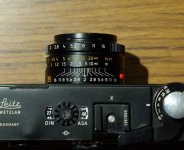csaunders
f8 and be there.
Hi,
Having only ever used autofocus SLRs, and having just bought my first rangefinder (a Zeiss Ikon ZM), I am wondering about how other people focus their rangefinders.
I tend to find that I hold the camera up to my eye and then I do a lot of focus 'hunting' to get the images to match up; which sometimes takes 15 seconds or more; and the photo is gone!
Should I learn to guesstimate the distance and prefocus before I hold the camera up to my eye? Should I learn to feel the focus by the position of the tab on the lens? Am I missing something entirely?
Also; I don't know if this is a problem specific to the Ikon, but despite having heard that rangefinders are the ideal camera to focus in low light conditions, sometimes I really struggle to even see the rangefinder patch in low light, let alone line up the images...
One last thing; if you are trying to focus on an area that doesn't have much detail; it is impossible to tell sometimes if the images are lined up since there are no points of reference. What is the secret here?
Would love to hear the details of your focusing habits!
-Christian
Having only ever used autofocus SLRs, and having just bought my first rangefinder (a Zeiss Ikon ZM), I am wondering about how other people focus their rangefinders.
I tend to find that I hold the camera up to my eye and then I do a lot of focus 'hunting' to get the images to match up; which sometimes takes 15 seconds or more; and the photo is gone!
Should I learn to guesstimate the distance and prefocus before I hold the camera up to my eye? Should I learn to feel the focus by the position of the tab on the lens? Am I missing something entirely?
Also; I don't know if this is a problem specific to the Ikon, but despite having heard that rangefinders are the ideal camera to focus in low light conditions, sometimes I really struggle to even see the rangefinder patch in low light, let alone line up the images...
One last thing; if you are trying to focus on an area that doesn't have much detail; it is impossible to tell sometimes if the images are lined up since there are no points of reference. What is the secret here?
Would love to hear the details of your focusing habits!
-Christian


